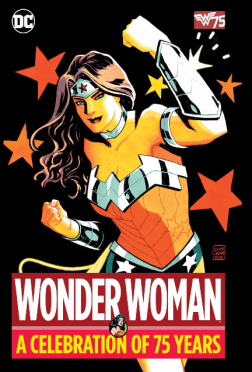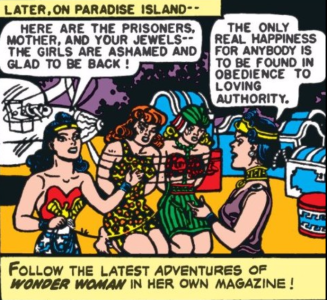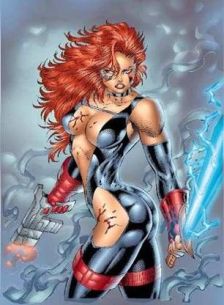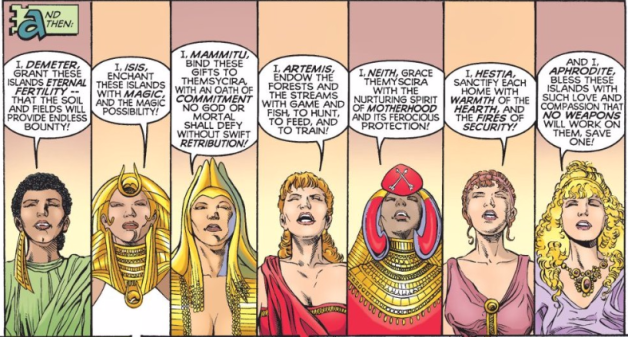This doorstopper of a collection is 400 pages of Wonder Woman from the Golden Age all the way to 2015, featuring just about every creator who’s ever made their mark on the character. It’s all here: first appearances, reboots, re-imaginings, William Moulton Marston’s bondage fetish, de-powerings, awkward phases, a variety of feminisms, and the occasional kangaroo.

For new fans who want to get up to speed on Wonder Woman’s history, this is much more fun than reading the Wikipedia article. It’s helpfully divided into four eras, each with an introduction covering creators of note, the overall tone of that time period, and a few major plot points. Like the 2014 Sensation Comics series, it also functions as a sample pack of writers and artists so you can start to figure out who you want on your reading list.
I had a few points of curiosity going in. Number one was obviously Marston, the OG – just how oddball was he and how much resemblance did his Wonder Woman bear to the character we have today? Numero B was George Pérez – a name I heard mentioned a lot in the context of how much the movie drew from his version of the character. I’d heard similar good things about Phil Jimenez. Then there was Brian Azzarello and Cliff Chiang, who handled things during the New 52 years. Finally, Jill Thompson, an Eisner winner whose fully painted original graphic novel Wonder Woman: The True Amazon (2016) was a bestselling take on Diana’s early years. So you know, a daunting amount of talent to explore.
As you might expect, the Golden Age (1940s-mid 50s) is…a bit of a culture shock for a modern reader. Comics back then were very much with the telling, not showing. Things like straight-up pulling plot points out of one’s ass were not uncommon.

I guess the thing to keep in mind is that comics in those days had to be cheap, fast and kid-friendly – though that last one didn’t stop Marston from inserting a fair amount of blatant Aesops about, um, submission.

Next we have the Silver Age, in which writer/artist team Denny O’Neil and Mike Sekowsky strip Diana of her powers and reinvent her as a private investigator and martial arts expert who owns a fashion boutique (Wonder Woman #179, 1968.) It’s a little odd. She’s learning things right from scratch that you’d sort of assume she already knew. Her martial arts instructor I Ching is not a terribly racially sensitive portrayal of an Asian character. Somehow this lasted until 1973, when Robert Kanigher took over as writer, put things back to normal and introduced the much-missed Nubia – Wonder Woman’s black counterpart.
After a big reboot event called Crisis on Infinite Earths, George Pérez wrote and drew Wonder Woman from 1987 to 1991. He’s represented in this collection with his first arc, “The Princess and the Power” (Wonder Woman #1, 1987, co-writer Greg Potter, inks Bruce Patterson), in which he re-does the origin story in a way that links Wonder Woman more closely to Greek legends. Patty Jenkins didn’t give Pérez a shout-out for nothing: he really does bring out the stirring emotion, the mythic grandeur, and then the sheer joy when Diana is finally revealed as Themyscira’s champion.


This era also starts to include a few more gritty elements than before – sexual violence, drug addiction, etc. The 90s were an…interesting time. Comics were trying to distance themselves from the bright and cheesy image of yore, so “dark and edgy” was the order of the day. Jill Thompson, as artist, and writer Bill Messner-Loebs take this on in “The Heart of the City” (Wonder Woman #64, 1992). The result is a badass crime adventure involving gangs, money-laundering and kidnapping, which is still bang-on character-wise and ends on a hopeful note.

Unfortunately, the other thing about the 90s was that everybody got a hard-on for this one artist called Rob Liefeld. He’s a bit controversial. He did co-create Deadpool, but he also liked to draw like this:


Aaand then everybody copied him, so the 1995 entry in this book looks like this:

To give artist Mike Deodato the benefit of the doubt, the plot (also written by Bill Messner-Loebs, what happened, my dude?) isn’t the greatest either: Hippolyta has forced Diana to give up being Wonder Woman in favour of another Amazon, Artemis. She’s not very good at it. It is as annoying as it sounds.
Moving thankfully along, Phil Jimenez! (“Paradise Found”, Wonder Woman #177, 2002, inks Andy Lanning.) He wrote and drew Wonder Woman from 2000-2003 and he clearly holds a deep reverence for George Pérez and the others who came before him, working in plenty of tributes that are easy to spot in a collection like this. (Keep an eye out for the blink-and-you’ll-miss-it shout-out to the Marston era when the Amazons had pet kangaroos!)


Jimenez’s Diana is on point: smart, humble, full of love, uninhibited, a savvy leader. There are some beautiful mother-daughter moments and Wonder Woman’s first black love interest, Trevor Barnes. And then I read this 2014 interview on CBR where he talks about Wonder Woman’s relationship to racial politics and sexual identity. Yep, he gets it.
You know who doesn’t, though, is Darwyn Cooke (“The Mother of the Movement”, Justice League: The New Frontier Special, 2008, art J Bone.) His contribution is a “militant feminist” Wonder Woman with oh, so many cringe moments. Slut-shaming, man-hating, just generally judgemental and horrendously out of character. Considering this was around the time Gail Simone was absolutely killing it on the main title, there’s not really any excuse for this bullshit:

Oddly, the Brian Azzarello/Cliff Chiang contribution is a “Before the New 52” story with Diana as a young teen (“The Lair of the Minotaur”, Wonder Woman #0, 2012). So I didn’t get to satisfy my curiosity on just what people seem to like so much about their New 52 run, but they did well enough with little Diana that I think I trust them to handle her as a grown-up. Although can somebody explain to me how exactly there are other kids on Themyscira who seem to have two parents?
We finish off with a few stories from Sensation Comics featuring Wonder Woman, the very first Wonder Woman comics I read, including Gail Simone’s “Gothamazon” (which is lucky because if they hadn’t included her I might have started my own tiny riot.) So I got to do a little reminiscing of my own. I feel like I’ve learned so much since this all started in June! I’m so glad, not only that I fell in love, but that I stayed that way.
Reading this collection felt like looking through someone’s childhood photo album. You see the character, and the comics industry itself, growing up in a series of snapshots. You see all the embarrassing moments preserved for posterity; you search in every portrait for the features you know so well; you notice the things they held onto that define who they eventually became. The story is told with so much love that it’s infectious: you find yourself looking back with nostalgia on this life you didn’t live. It creeps into your heart and makes a home there. I came out of this with a much stronger understanding of Wonder Woman’s history, but also a deeper love.
Next up: I asked the comics community on Twitter for their best comic convention tips for newbies, and got some great responses from fans and creators. Stay tuned for How To Do Comic Con Like A Pro!

Blatant Aesops is the name of my new rap band.
Also I love curly haired Diana. More of this please.
Aww, you got genuinely beautiful at the end there. I’m so glad this has been your experience. Couldn’t be more perfect.
LikeLiked by 1 person
“Hi we’re the Blatant Aesops and this is our hit single The True Meaning Of Christmas Was The Friends We Made Along The Way.”
Omg, her 80s hair was SO 80S. And you are a sweetheart ❤ you were the second half of the catalyst!
LikeLike